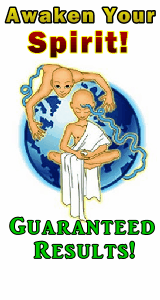Body, Mind and Spirit: Understanding the Links Between Health and Consciousness
![]() Tracy Kolenchuk, Guest
Tracy Kolenchuk, Guest
Waking Times
Body, mind, and spirit are often presented as the “wholeness” of health. However, body, mind, and spirit are poorly defined, poorly distinguished and poorly articulated in many health (sick care) practices.
Philosophers have pondered – for centuries and more – the definitions and locations of mind, and spirit. We often confuse, or mix discussions of body, mind, and spirit with body, mind, and soul. I will not discuss the concept of ‘soul’.
We each have one body, at least two brains, many minds, and many, many spirits. To develop a science of healthicine – as opposed to medicine – we need useful, functional, practical definitions and distinctions.
The Brain
We can start with the brain. In the hierarchy, the brain is an organ, or a number of organs. As an organ, it is a collection of tissues that perform certain functions – sensing, filtering the senses, and reacting to sensations. The brain is part of the whole body – the collection of all body parts.
Where do you find the mind? In the body? Or in the brain? Nowhere. The mind is separate from the body, separate from the brain. We cannot find the mind in the brain.
How do we recognize the mind, and recognize components and functions of the mind, from components and functions of the brain? The brain can exist without consciousness – the mind is consciousness. There are animals that have a nervous system but no mind. The first functions of the nervous system are to sense danger and food, and then to move the body away from the danger and towards food. When does the mind emerge from the brain? It’s a difficult question, so I propose a simple answer. When we learn to pee. To pee, or not to pee. That is the answer.
Gradually, animals develops sentience, the first hints of thinking consciousness. We don’t need to draw an exact line – we only need a useful distinction. The mind is conscious. Boxers are knocked ‘unconscious’ for short periods of time. We make conscious decisions that can be incredibly complex. The line between the brain and the minds lies in conscious control of the minds, over the body. Yes, we have more than one mind, we are of more than one mind, indecision is an important component of intelligence, an important component of healthiness.
The Spirit
 What about spirit? When does our spirit emerge? Shakespeare’s Hamlet discussed a battle of minds and spirits. Our spirits are our wills, our desires, our longings, to live, or not. To be, or not to be. We do not have one spirit. We have many. Take care, it’s easy to confuse ‘sensations’ with ‘spirits’. Some feelings are what we sense. We smell food – and move forward. We feel intolerable heat – and move away from danger. These sensations are feelings. And spirits? We anticipate danger, and we want to move away from it. This is our spirit. Indirect, separate from direct ‘sensation’. Of course we translate our spirits back into feelings, and complexity arises. We think about death, “to be or not to be”, the thought of death drives away the joy of life, drives away the fear of the pain of dying, and we feel melancholy. Is melancholy a feeling? Or a spirit?
What about spirit? When does our spirit emerge? Shakespeare’s Hamlet discussed a battle of minds and spirits. Our spirits are our wills, our desires, our longings, to live, or not. To be, or not to be. We do not have one spirit. We have many. Take care, it’s easy to confuse ‘sensations’ with ‘spirits’. Some feelings are what we sense. We smell food – and move forward. We feel intolerable heat – and move away from danger. These sensations are feelings. And spirits? We anticipate danger, and we want to move away from it. This is our spirit. Indirect, separate from direct ‘sensation’. Of course we translate our spirits back into feelings, and complexity arises. We think about death, “to be or not to be”, the thought of death drives away the joy of life, drives away the fear of the pain of dying, and we feel melancholy. Is melancholy a feeling? Or a spirit?
Gradually, as complexity grows, consciousness grows to develop awareness of ‘self’. Self-consciousness is an attribute and function of the mind. The mind can remember and think. It can be aware that it is thinking. It can think about thinking. It can think about thinking about thinking, and so on. All the while, the mind is also affected by bodily sensations, feelings, etc. Do whales and elephants, who also have large brains, think about thinking? Or is language required? More questions that might never be answered.
Our minds and our spirits evolved together. They are intricately interlinked, interwoven. Maybe it is folly to try and separate them. Maybe not.
The Mind
People have complex minds, which we use to manipulate not just our body, not just our mind, but also our spirits. We can want to be calm. We can take some deep breaths, and calm our body, minds and spirits. We can use our mind to control our spirits, and we can use our spirits to control our mind. It’s not simple. It shouldn’t be. To ‘want to be’ is an action of spirit, even when the ‘want’ is in the past.
Our mind can sense our feelings, our wants, our spirits. We can use our conscious mind to look at our sensations and ‘feel our own pain’, past – present, and future, and ‘sense our own joy’ – past, present, and future. It can calculate and decide, taking many, often conflicting desires into consideration. Or, as in Hamlet’s soliloquy, it might decide to not decide, but to ponder. Or did Hamlet’s spirit override the mind, asking the mind to ponder termination of life, and with it, termination of the spirit?
 As the mind cannot be found in the nervous system, the brain, or the body, the spirit cannot be found in the mind. It emerges as the complexity of the mind, the brain, the body rises. The spirit can fade too, if the body, brain, and mind are so overloaded that they can barely perform their base functions. The mind too can fade or disappear when we are knocked unconscious. When we say someone is ‘brain dead’ – they often have a brain, but it is not in control. They are ‘mind dead’, ‘spirit dead’. This circumstance can be mild, moderate, or severe as the mind and the spirit shrink or lose function. Our medical systems, with their fear of ‘spirits’, don’t recognize spirit death nor weakness of spirit – except perhaps in a moralistic sense.
As the mind cannot be found in the nervous system, the brain, or the body, the spirit cannot be found in the mind. It emerges as the complexity of the mind, the brain, the body rises. The spirit can fade too, if the body, brain, and mind are so overloaded that they can barely perform their base functions. The mind too can fade or disappear when we are knocked unconscious. When we say someone is ‘brain dead’ – they often have a brain, but it is not in control. They are ‘mind dead’, ‘spirit dead’. This circumstance can be mild, moderate, or severe as the mind and the spirit shrink or lose function. Our medical systems, with their fear of ‘spirits’, don’t recognize spirit death nor weakness of spirit – except perhaps in a moralistic sense.
We can recognize the mind, and the spirit. The mind exercises control, sometimes in very, very complex ways. The spirit wants to exercise control, even if we are not certain what we want.
Community
There is another layer in the hierarchy of life, the hierarchy of healthicine. We each have many minds, many spirits, but one body. When we combine our bodies, our minds and our spirits, we create another layer – community. We create communities that are very, very complex, that have minds, and wills – spirits of their own. There is no difficulty distinguishing community from body, minds and spirits. Maybe that’s why community is almost invisible to health (sick care) practitioners – because it is in plain sight. Easy: to see, or not to see.
To your health, Tracy
About the Author
Tracy is the founder of Healthicine.org and the site PersonalHealthFreedom.blogspot.com, where he expects to change the way the world defines and looks at health, healthiness and healthicine.
 Disclaimer: This article is not intended to provide medical advice, diagnosis or treatment. Views expressed here do not necessarily reflect those of WakingTimes or its staff.
Disclaimer: This article is not intended to provide medical advice, diagnosis or treatment. Views expressed here do not necessarily reflect those of WakingTimes or its staff.
This article is offered under Creative Commons license. It’s okay to republish it anywhere as long as attribution bio is included and all links remain intact.
~~ Help Waking Times to raise the vibration by sharing this article with the buttons below…